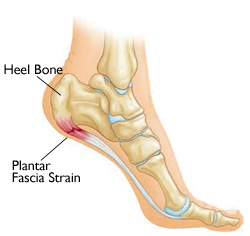
Overview
Plantar fasciitis is an inflammation (irritation and swelling with presence of extra immune cells) of the thick tissue on the bottom of the foot that causes arch pain, heel pain and disability.
The plantar fascia is a very thick band of tissue that covers the bones on the bottom of the foot. This fascia can become inflamed and painful in some people with exsessive pronation (calapsing arch), making walking more difficult and often very painful.
Symptoms
The most common complaint is pain in the bottom of the heel, usually worst in the morning and improving throughout the day. By the end of the day the pain may be replaced by a dull aching that improves with rest.
Plantar fasciitis is an inflammation (irritation and swelling with presence of extra immune cells) of the thick tissue on the bottom of the foot that causes arch pain, heel pain and disability.
The plantar fascia is a very thick band of tissue that covers the bones on the bottom of the foot. This fascia can become inflamed and painful in some people with exsessive pronation (calapsing arch), making walking more difficult and often very painful.
Symptoms
The most common complaint is pain in the bottom of the heel, usually worst in the morning and improving throughout the day. By the end of the day the pain may be replaced by a dull aching that improves with rest.
Signs and Tests
Typical physical exam findings include tenderness on the bottom of the heel, closer to the midline, and mild swelling and redness.
X-rays may be taken to rule out other problems, but the presence or absence of a heel spur is not significant.
Treatment
Conservative treatment is almost always successful, given enough time. Duration of treatment can be anywhere from several months to 2 years before symptoms resolve, although about 90% of patients will be better in 9 months.
Initial treatment usually consists of heel stretching exercises, custom orthotics (with heel cut out cushion accommodation & heel spur accommodation when spurs are present), night splints, and anti-inflammatory medications. If these fail, casting the affected foot in a short leg cast (a cast up to but not above the knee) for 3-6 weeks is very often successful in reducing pain and inflammation. Alternatively, a cast boot (which looks like a ski boot) may be used. It is still worn full time, but can be removed for bathing.
Some physicians will offer steroid injections, which provide lasting relief in about 50% of people. However, this injection is very painful and not for everyone.
In a few patients, non-surgical treatment fails and surgery to release the tight, inflamed fascia becomes necessary.
Prevention
Maintaining good flexibility around the ankle and wearing custom orthotics with adequate arch support is probably the best way to prevent plantar fasciitis.
Typical physical exam findings include tenderness on the bottom of the heel, closer to the midline, and mild swelling and redness.
X-rays may be taken to rule out other problems, but the presence or absence of a heel spur is not significant.
Treatment
Conservative treatment is almost always successful, given enough time. Duration of treatment can be anywhere from several months to 2 years before symptoms resolve, although about 90% of patients will be better in 9 months.
Initial treatment usually consists of heel stretching exercises, custom orthotics (with heel cut out cushion accommodation & heel spur accommodation when spurs are present), night splints, and anti-inflammatory medications. If these fail, casting the affected foot in a short leg cast (a cast up to but not above the knee) for 3-6 weeks is very often successful in reducing pain and inflammation. Alternatively, a cast boot (which looks like a ski boot) may be used. It is still worn full time, but can be removed for bathing.
Some physicians will offer steroid injections, which provide lasting relief in about 50% of people. However, this injection is very painful and not for everyone.
In a few patients, non-surgical treatment fails and surgery to release the tight, inflamed fascia becomes necessary.
Prevention
Maintaining good flexibility around the ankle and wearing custom orthotics with adequate arch support is probably the best way to prevent plantar fasciitis.

 RSS Feed
RSS Feed
